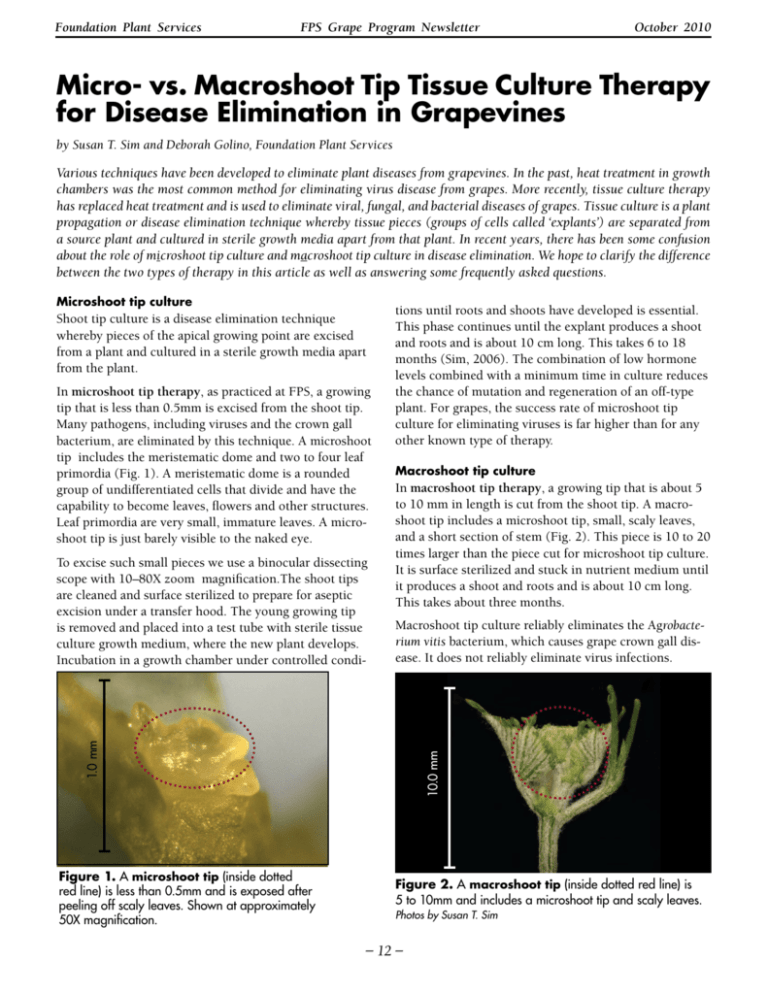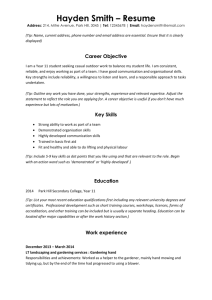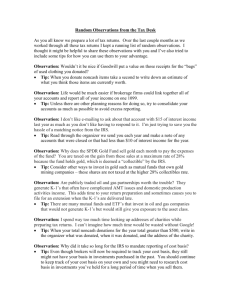Micro- vs. Macroshoot Tip Tissue Culture Therapy for Disease
advertisement

Foundation Plant Services FPS Grape Program Newsletter October 2010 Micro- vs. Macroshoot Tip Tissue Culture Therapy for Disease Elimination in Grapevines by Susan T. Sim and Deborah Golino, Foundation Plant Services Various techniques have been developed to eliminate plant diseases from grapevines. In the past, heat treatment in growth chambers was the most common method for eliminating virus disease from grapes. More recently, tissue culture therapy has replaced heat treatment and is used to eliminate viral, fungal, and bacterial diseases of grapes. Tissue culture is a plant propagation or disease elimination technique whereby tissue pieces (groups of cells called ‘explants’) are separated from a source plant and cultured in sterile growth media apart from that plant. In recent years, there has been some confusion about the role of microshoot tip culture and macroshoot tip culture in disease elimination. We hope to clarify the difference between the two types of therapy in this article as well as answering some frequently asked questions. Microshoot tip culture Shoot tip culture is a disease elimination technique whereby pieces of the apical growing point are excised from a plant and cultured in a sterile growth media apart from the plant. In microshoot tip therapy, as practiced at FPS, a growing tip that is less than 0.5mm is excised from the shoot tip. Many pathogens, including viruses and the crown gall bacterium, are eliminated by this technique. A microshoot tip includes the meristematic dome and two to four leaf primordia (Fig. 1). A meristematic dome is a rounded group of undifferentiated cells that divide and have the capability to become leaves, flowers and other structures. Leaf primordia are very small, immature leaves. A microshoot tip is just barely visible to the naked eye. Macroshoot tip culture In macroshoot tip therapy, a growing tip that is about 5 to 10 mm in length is cut from the shoot tip. A macroshoot tip includes a microshoot tip, small, scaly leaves, and a short section of stem (Fig. 2). This piece is 10 to 20 times larger than the piece cut for microshoot tip culture. It is surface sterilized and stuck in nutrient medium until it produces a shoot and roots and is about 10 cm long. This takes about three months. Macroshoot tip culture reliably eliminates the Agrobacterium vitis bacterium, which causes grape crown gall disease. It does not reliably eliminate virus infections. Figure 1. A microshoot tip (inside dotted red line) is less than 0.5mm and is exposed after peeling off scaly leaves. Shown at approximately 50X magnification. 10.0 mm 1.0 mm To excise such small pieces we use a binocular dissecting scope with 10–80X zoom magnification.The shoot tips are cleaned and surface sterilized to prepare for aseptic excision under a transfer hood. The young growing tip is removed and placed into a test tube with sterile tissue culture growth medium, where the new plant develops. Incubation in a growth chamber under controlled condi- tions until roots and shoots have developed is essential. This phase continues until the explant produces a shoot and roots and is about 10 cm long. This takes 6 to 18 months (Sim, 2006). The combination of low hormone levels combined with a minimum time in culture reduces the chance of mutation and regeneration of an off-type plant. For grapes, the success rate of microshoot tip culture for eliminating viruses is far higher than for any other known type of therapy. Figure 2. A macroshoot tip (inside dotted red line) is 5 to 10mm and includes a microshoot tip and scaly leaves. Photos by Susan T. Sim – 12 – Foundation Plant Services FPS Grape Program Newsletter October 2010 Table 1. Comparison of Micro vs. Macro Shoot tip culture Key Microshoot tip culture Macroshoot tip culture Explant size < 0.5 mm 5 to 10.0 mm Result Eliminates many pathogens—including viruses and crown gall Eliminates one pathogen - crown gall Number of tips excised per hour 10 (approx.) 50 (approx.) Average time required to grow into a 10 cm tall plant with roots 6 – 18 months 3 months Cost $$$$/ plant to produce $/plant to produce FPS Location All selections planted at Russell Ranch will be treated with microshoot tip culture. Many selections in the current Foundation Vineyard were treated with this technique. All selections planted in the Goheen Block (Next Generation Vineyard) were treated with a minimum of macroshoot tip culture; some of them received microshoot tip culture instead. These selections were propagated from registered vines in the current Foundation Vineyard. FREQUENTLY ASKED QUESTIONS Q: What is the difference between microshoot tip and macroshoot tip culture therapy? A: As the names imply, the difference between micro and macro shoot tip culture is in the size of the growing tip excised. In microshoot tip therapy, we excise a miniscule piece of tissue—less than 0.5 mm. Depending on the variety and condition of the shoot, the pieces range from as small as 0.2 mm to 0.45 mm at their largest diameter. In macroshoot tip therapy, a growing tip that is about 10 mm in length is cut from the shoot tip. This macroshoot tip includes the meristem dome, many leaf primordia, small, scaly leaves, and a short section of stem (Fig. 2). It is surface sterilized and stuck in nutrient medium until it produces a shoot and roots and is about 10 cm long. This takes about 3 months. Microshoot tip therapy is more difficult and much slower, but reliably eliminates virus infections. If crown gall disease is the only reason to perform therapy, macroshoot tip culture is faster and less labor intensive, and therefore less expensive. Q: Which pathogens does microshoot tip tissue culture therapy eliminate? A: Microshoot tip therapy effectively eliminates many grape pathogens including fungi, bacteria, and, most important to FPS programs, grapevine viruses. More than 60 grapevine viruses have now been described (Martelli, 2009); to date, any grapevine infected with a known virus can be treated successfully with microshoot tip culture. Among those viruses are: Grapevine leafroll-associated viruses, that are associated with leafroll disease; Nepoviruses, examples of which are Grapevine fanleaf virus and Tomato ringspot virus; Vitiviruses, such as Grapevine virus A, B, and D that are associated with rugose wood diseases; and Rupestris stem pitting-associated virus, also associated with rugose wood disease. In addition, the Agrobacterium vitis bacterium, which causes grape crown gall disease, is also eliminated with this therapy. It is generally believed that some fungal diseases can also be eliminated with both macro- and microshoot tip culture, but data on this is limited. Q: Which pathogens does macroshoot tip tissue culture therapy eliminate? A: In contrast to microshoot tip culture, macroshoot is not known to eliminate any viruses or virus-like pathogens. It is known to effectively eliminate Agrobacterium vitis bacterium, which causes grape crown gall disease. It is generally believed that some fungal diseases can also be eliminated with both macro- and microshoot tip culture, but data on this is limited. Q: What does meristemming mean? A: One of the textbook disease elimination methods for plants is known in the nursery industry as ‘meristemming’ or, more technically, as ‘meristem tip culture’ which is very effective for eliminating most viral, bacterial and – 13 – Foundation Plant Services FPS Grape Program Newsletter October 2010 fungal contaminants (Faccioli and Marani, 1998). In this technique, the tissue pieces (cells known collectively as the explant) are harvested from a meristem tip of the plant. The meristem tip is the actively growing tissue at the tip of the shoot which has not yet differentiated into leaves or shoots (Figure 1). Many scientists reserve the term meristem tip culture for explants that only include a very few cells which make up the meristem which would be approximately 0.1 mm long depending on the plant species (Murashige, personal communication); others define a meristem culture as those taken from much larger explants as long as they are smaller than 1 mm (Hartmann et al., 1997). In the trade, this term is sometime even used to include explants as large as those we call macroshoot tip cultured. Since this term is often misused to include clonal propagation and shoot tips far larger than a meristem, we avoid use of this term at FPS. In our experience at FPS, for satisfactory virus elimination in grapevines, a meristem tip of less than 0.5 mm must be cut (Golino et al., 2000 ). We refer to this as ‘microshoot tip tissue culture’ to avoid any ambiguity about the term ‘meristemming’ and/or ‘meristem tip culture’. The piece excised includes the meristem dome and one or two leaf primordia. Theoretically, to optimize successful virus elimination, only the meristem dome would be excised. However, when we have excised just the meristematic dome of a grape shoot, it has not survived. Q: If microshoot tip therapy can eliminate so many more pathogens than macroshoot tip therapy, why don’t we always use it? A: As mentioned above, we always use microshoot tip therapy for the elimination of viruses. However, it is much more difficult and requires much longer than macroshoot tip culture. In certain instances, macroshoot tip therapy to eliminate crown gall bacterium was the only therapy needed. This was true for the Next Generation Vineyard which was originally created to provide selections free of crown gall disease so that grapevine nurseries could propagate planting stock that was crown gall free. Q: Which therapy was used to produce the current Foundation Vineyard? A: The current Foundation vineyard contains a mix of vines which have received no therapy, heat treatment therapy (generally pre-1990), and/or microshoot tip therapy (generally post-1990). Selections that tested negative for viruses of quarantine concern and were qualified according to regulations current at the time to be registered with the CDFA Grapevine Registration and Certification program were planted in the Foundation Vineyard without therapy. Heat treatment or microshoot tip therapy was used on selections planted in the Foundation Vineyard if they had tested positive for pathogens when FPS received them and, in some cases where the selections were very valuable, as a precaution in case the original selection didn’t pass the required tests. After therapy, plants were tested, and planted in the Foundation Vineyard if all required tests were negative. Q: Which therapy was used to produce the Goheen block or Next Generation Vineyard? A: Macroshoot tip therapy to eliminate crown gall was used to produce all rootstocks in the Next Generation Vineyard and some of the scion selections. At the time this vineyard was planned, there was much concern about possible crown gall in the FPS Foundation Vineyard. Although this is not a primary concern in many California vineyards, it is in colder climates. FPS wants to supply the best possible plant material, so in response we repropagated the most popular rootstock and scion varieties from the Foundation Vineyard using macroshoot tip therapy to eliminate crown gall. The vines we re-propagated were already registered and virus tested negative, so they did not need to be treated for virus elimination with the much more difficult and time-consuming microshoot tip culture method. The Next Generation Vineyard contains 40 selections that have received only macroshoot tip therapy and 22 selections that have received microshoot tip therapy. All Next Generation vines are registered and tested negative for viruses of concern to the CDFA Grapevine Certification Program at the time of planting. Dr. Tom Burr, Cornell University, has tested all the rootstock vines for crown gall and they have tested negative. The Next Generation Vineyard was planned and propagated before FPS received the new 100 acres of land at Russell Ranch and funding to allow an accelerated testing and therapy program for this new Foundation. Q: How does a nursery or a grower learn about the type of tissue culture therapy received by a particular selection? A: All FPS grapevine selections available to nurseries and growers are included on the National Grape Registry (NGR) website www.ngr.ucdavis.edu. Selections with Registered or Provisional status in the California Grapevine – 14 – Foundation Plant Services FPS Grape Program Newsletter October 2010 R&C Program, including all the vines in the current foundation vineyard and the Goheen Next Generation planting, are accessible on the NGR via the ‘Varieties’ button located at the top of each page on the site. A website user searching for a particular FPS selection should first proceed to the Variety page for the selection of interest. A click on the phrase ‘View Clone List’ will reveal a series of descriptive profiles of all the FPS selections for that variety, e.g., Harmony FPS 05. One of the components in the profile for each selection is a line entitled ‘Treatments,’ which provides information about any virus therapy the selection has received. Examples of treatments are ‘None,’ ‘Heat Treatment 168-2 days’ (the second vine removed from heat treatment after 168 days), or ‘Microshoot tip tissue culture therapy.’ The words ‘Macroshoot tip tissue culture therapy’ will not appear on the Treatments line for the selections in the Goheen vineyard. When the original foundation material of an FPS selection underwent macroshoot tip tissue culture therapy in order to be planted in the Goheen vineyard, FPS did not give the new treated Goheen vines a new selection number (as is done when microshoot tip tissue culture is used). Therefore, the original (untreated) foundation grapevine material and the treated Goheen vines both have the same selection number and are both available for distribution through FPS. In order to inform NGR users that both versions of the selection are available, the comment section on the NGR website for the Goheen vines reads: “In addition to the plant material in the regular blocks in the Foundation Vineyard, Harmony FPS 05 is also available from FPS’ Next Generation Vineyard. All vines in that vineyard were created using shoot tip tissue culture therapy designed to eliminate bacterial contaminants such as Agrobacterium vitis (crown gall disease).” This wording was developed for the NGR site before the term ‘macroshoot tip culture’ came into use at FPS. Discussions are now underway about renumbering or renaming selections that have been through shoot tip tissue culture therapy, particularly for those selections which are well known by their existing FPS selection numbers and which are now undergoing therapy for transfer to the Russell Ranch Foundation. Q: Which therapy will be used to produce the new Russell Ranch Vineyard? A: All selections that will be planted in the Russell Ranch Vineyard will be produced using microshoot tip tissue culture disease elimination therapy for viruses. We believe this will provide planting stock free of unknown cryptic viruses as well as those viruses for which we have developed tests. By default, this material should also be free of the bacteria which cause crown gall disease. Additionally, the material will be subjected to rigorous testing using advanced technology and innovative pathogen identification methods as defined by the ‘Protocol 2010’ (see article in this newsletter page 10). FPS has identified ~200 scions and rootstocks that most likely will meet that protocol. By the winter of 2011, we hope to have completed testing of those scions and rootstocks so that we will be able to plant a large number of the selections in the spring of 2011 as well as distribute mist-propagated plants (MPPs) from those selections. Q: Do some of the vines in the current Foundation Vineyard meet the ‘2010 Protocol’ standard? Which ones qualify? A: We expect to have a list by January or February of 2011 of vines in the current Foundation at FPS which meet the standards of the ‘2010 Protocol’. They will be the highest level of material (for virus status) from FPS. _ REFERENCES Faccioli, G. and Marani, F. 1998. Virus Elimination by Meristem Tip Culture and Tip Micrografting. Pages 346–381 in: Plant Virus Disease Control. A. Hadidi, R.K. Khetarpal, and H. Koganezawa, eds. APS Press, American Phytopathological Society, St. Paul, Minnesota. Golino, D.A., S.T. Sim, J. Bereczky, and A. Rowhani, 2000. The Use of Shoot Tip Culture in Foundation Plant Materials Service Programs. Proc. Int. Plant Propagation Soc. 50: 568–573. Martelli, G.P. 2009. Grapevine Virology Highlights 2006-2009. Progrès Agricole et Viticole, 2009, Hors Série—Extended abstracts 16th Meeting of ICVG, Dijon, France, 31 Aug–4 Sept 2009, pp15–24. Sim, Susan T. 2006. Virus Elimination from Grape Selections Using Tissue Culture. FPS Grape Program Newsletter, Foundation Plant Services, University of California, Davis, pp 30–31. – 15 –





